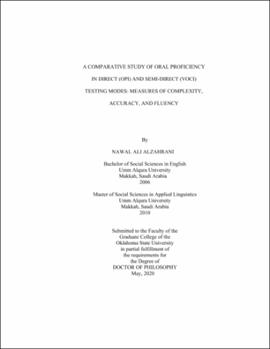| dc.contributor.advisor | Halleck, Gene | |
| dc.contributor.author | Alzahrani, Nawal Ali | |
| dc.date.accessioned | 2020-09-09T20:49:12Z | |
| dc.date.available | 2020-09-09T20:49:12Z | |
| dc.date.issued | 2020-05 | |
| dc.identifier.uri | https://hdl.handle.net/11244/325439 | |
| dc.description.abstract | This study aims at comparing oral proficiency performance at two oral proficiency testing modes, namely Oral Proficiency Interview (OPI) and Video Oral Communication Instrument (VOCI) in terms of specific measures of complexity (length of ASUs, and MS-TTR), accuracy (error-free ASUs), and fluency (frequency of filled and silent pauses). It also examines the relation between task type and CAF measures in both testing modes. It further explores the test takers' perceptions and preferences towards the direct testing mode (OPI) and the semi-direct testing mode (VOCI), and then compares those perceptions and preferences with their testing performance in terms of the CAF measures. In order to achieve the goals of this study, four instruments were used to collect the data (OPI, VOCI, online background survey, and interviews conducted in Arabic). Convenience sampling was used to recruit nine senior Saudi male students, majoring in different fields in Engineering at a South-Central University in the United States. OPIs and VOCIs responses were recorded, then manually transcribed using InqScribe software. Wilcoxon Signed Rank test reveals that while complexity measures did not show any statistically significant differences in both testing modes, accuracy (Error-free ASU) and fluency (Silent pauses) showed significant differences in the OPI and VOCI testing modes. It was also found that the narrative task impacted the MS-TTR in the VOCI testing mode and the number of silent pauses in the OPI testing mode. Participants reported a variety of positive and negative perceptions towards OPI and VOCI. This study further presents information about test takers' experiences about both tests. It was also found that participants had a higher accuracy and fluency in the OPI testing that they claimed they felt more comfortable with. The current research suggests possible empirical and practical implications and some questions for future studies. | |
| dc.format | application/pdf | |
| dc.language | en_US | |
| dc.rights | Copyright is held by the author who has granted the Oklahoma State University Library the non-exclusive right to share this material in its institutional repository. Contact Digital Library Services at lib-dls@okstate.edu or 405-744-9161 for the permission policy on the use, reproduction or distribution of this material. | |
| dc.title | Comparative study of oral proficiency in direct (OPI) and semi-direct (VOCI) testing modes: Measures of complexity, accuracy, and fluency | |
| dc.contributor.committeeMember | Cheng, An | |
| dc.contributor.committeeMember | Link, Stephanie | |
| dc.contributor.committeeMember | Kennison, Shelia | |
| osu.filename | Alzahrani_okstate_0664D_16659.pdf | |
| osu.accesstype | Open Access | |
| dc.type.genre | Dissertation | |
| dc.type.material | Text | |
| thesis.degree.discipline | English | |
| thesis.degree.grantor | Oklahoma State University | |
